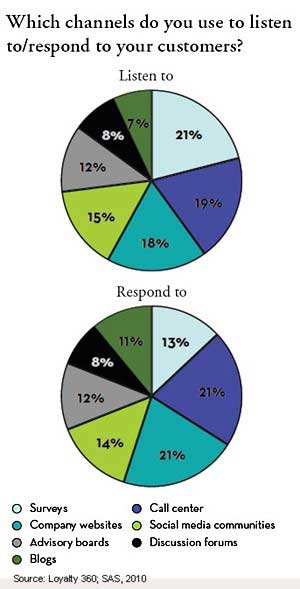Though B2B marketers report most of their new sales coming from their current customers, only one-half (55.4%) say their companies have departments that focus primarily on customer retention, according to a survey by Loyalty 360 and SAS. And among those with formal loyalty programs, most are using traditional channels such as surveys and call centers to listen and respond to customers.
Companies' customer bases are key revenue drivers: 44.6% of surveyed B2B marketers say at least 60% of their new sales are generated via their current customers, and nearly three-quarters (72%) say at least 20% of new sales come from such customers:

Below, other findings from the study Customer Loyalty Techniques for Business to Business Marketing Programs, based on a survey of 250 B2B marketers.
Among the roughly one-half of companies with formal customer retention programs, nearly two-thirds align their loyalty efforts to a customer-lifecycle (53.6%) or a voice-of-the-customer program (10.7%). Among that two-thirds, most (43%) begin their programs at initial lead contact; 21% begin immediately after the sale; and 18% begin their loyalty marketing efforts some three to six months after the sale.
Companies Listening, Responding via Traditional Channels
Companies are using a wide variety of communication channels to interact with customers.
Listening is most often done via surveys (21%) and (19%) call centers. Only 15% of brands listen to customers via social media communities, and 7% listen via blogs.

Meanwhile, responding to customers is most often done via call centers (21%) and websites (21%). Roughly 14% respond to customers via social media, and 11% respond via blogs.
Looking for great digital marketing data? MarketingProfs reviewed hundreds of research sources to create our most recent Digital Marketing Factbook (May 2010), a 296-page compilation of data and 254 charts, covering email marketing, social media, search engine marketing, e-commerce, and mobile marketing. Also check out The State of Social Media Marketing, a 240-page original research report from MarketingProfs.
Measurement
Companies are also using a variety of metrics to measure the success of retention campaigns, including satisfaction and loyalty metrics (26%), retention and attrition rates (21%), and revenue (17%).

Exec-Level Buy-in Critical
Among those B2B companies with dedicated loyalty departments, 93.9% say they had senior-level executive support for creating such organizations. Moreover, more than one-third (36.4%) say their loyalty departments report directly to the CEO; 21.2% report to the SVP or VP of marketing; and 15.2% report to the SVP or VP of sales.
Across the surveyed companies, loyalty departments are composed of customer service reps (26%), marketing support staff (23%), tech resources staff (18%), sales (15%), and market research staff (14%).
About the data: Findings are from a survey of 250 marketers from a cross section of B2B industries, conducted in September and October, 2010.



